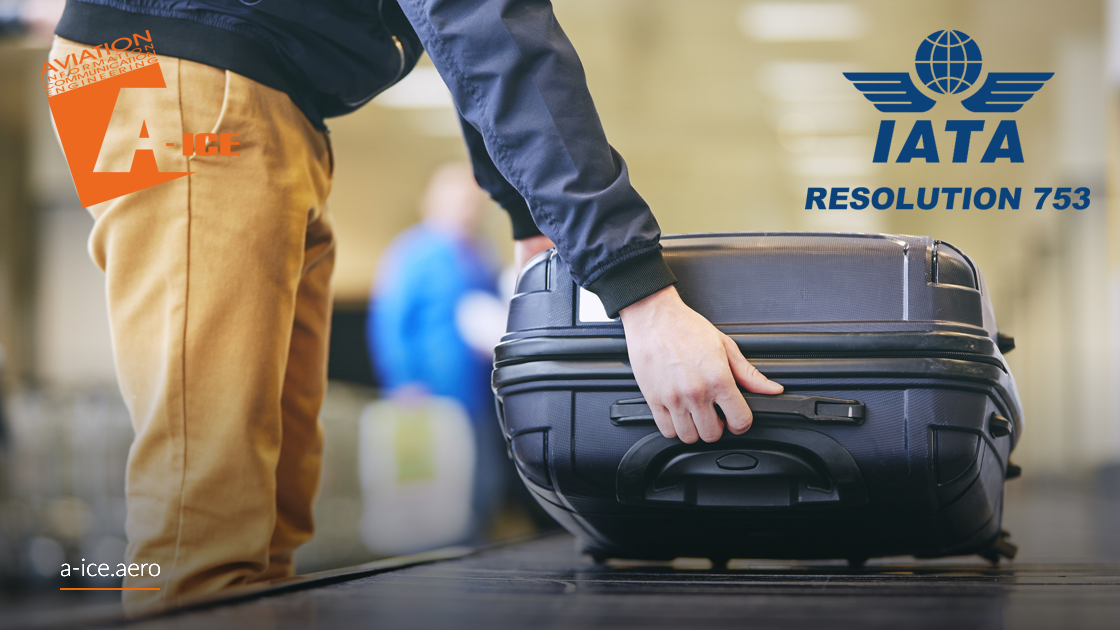IATA R753 – Who is responsible? Airline or airport?
| Company | A-ICE |
|---|---|
| Date | 31.10.2019 |
IATA’s Resolution 753 was implemented in 2018 in a bid to improve the airport baggage tracking system with an ultimate aim to reduce the number of lost and misdirected bags which costs the industry billions of Euros every year. The IATA R753 statement says: ‘IATA Resolution 753 on baggage tracking is intended to encourage airlines to further reduce mishandling by implementing cross-industry tracking for every baggage journey.’
The resolution was initially requested by IATA member airlines. Approved back in 2013 by the Joint Passenger Services Conference, the responsibility of meeting R753 guidelines falls squarely on the shoulders of those member airlines. Airlines were given the 5-year grace period to allow time to prepare, assess current procedures and implement solutions and procedures. However, IATA admit that there are challenges faced by airlines in the implementation of baggage tracking in terms of (in many cases) inevitable infrastructural changes that need to be made, particularly with older baggage handling systems.
This is why it has been important for airlines, airport operators and key stakeholders to take a collaborative approach to the implementation of strategies that enable the core benefits that R753 is designed to deliver.
How airports and airlines can collaborate to meet the R753 initiative
Although the obligation to meet R753 rests with IATA and member airlines, support is needed from other stakeholders with an interest in the baggage journey such as ground handling teams and airport operators to ensure full compliance and ultimately, the success of the initiative – i.e. a genuine reduction in lost and misdirected luggage and increased passenger experience and satisfaction.
According to the R753 initiative, baggage must be tracked at four key points in the baggage journey:
- Passenger handover to airline
- Loading to the aircraft
- Deliver to the transfer area
- Return to the passenger
Loaded baggage must also be matched to a boarded passenger and the data must be made available to other partners, such as during interlining journeys, which still accounts for almost half of all misdirected luggage.
To enable accurate tracking at each point, airports infrastructure can be harnessed to allow secure access to this critical data using some of the latest technologies and solutions. Airports around the world have been turning to integrable, cloud-based technologies to enable this flexibility. An increasing number of airports are also discussing and implementing integral ground handling teams to allow airlines to better meet the guidelines for baggage tracking.

Other benefits of infrastructural airport investment
As airports grow busier and expect this to continue in the future, there are other benefits to be realised from the integration of solutions and systems across the entire baggage system. Passenger experience and satisfaction is a higher priority and every system that talks to another within the infrastructural environment is increasing efficiency, making airports management and visibility more streamlined.
Enabling baggage tracking is just one way that airports can benefit from baggage handling solutions. Passengers are generally happier having more control over their journey and the introduction of integrated, self-service bag drop is ensuring queues are shorter and the passenger processing system is enhanced. Security can also be enhanced and made less painful for airport passengers with the addition of integrable systems that streamline processes and reduce the need for additional and numerous security checks.
Working with airlines to achieve compliance and regulate baggage tracking processes is benefitting airports and other key stakeholders. Analysis of tracking data also reveals insights into airport flow patterns and can enable faster departure readiness of aircraft. Measurement of airport compliance data, such as SLAs can be further streamlined with baggage tracking data and instances of baggage fraud can be almost eliminated.
How A-ICE can help?
A-ICE (https://www.a-ice.aero/) uses in-depth knowledge and experience to deliver a robust, comprehensive solution for airlines and airports to help with IATA R753 compliance. Working with industry stakeholders at all levels, A-ICE has developed a fully integrated suite of solutions that tick the boxes for baggage handling very firmly.
Our Baggage Reconciliation System (A-BRS) (https://www.a-ice.aero/a-brs/) helps airports, airlines and ground handlers to assure that no baggage is loaded if the passenger is not onboard a specific flight, to quickly offload bags of no-show passengers, to reduce delays and tell load controllers exactly where to locate their bag.
It has been developed always keeping in mind the main obligations set out in R753:
- Demonstrate delivery of baggage when custody changes;
- Demonstrate acquisition of baggage when custody changes;
- Provide an inventory of bags upon departure of a flight.
A-BRS provides customizable loading strategies based on rules and constrains that allow each airline and baggage handler to configure its own set of tracking points to demonstrate the acquisition of the bag by the airline/handler and the delivery of the bag on to the aircraft. Additional tracking points can be configured in case of complex airport environments.
In addition to the normal BRS scope (Outbound baggage handling), A-BRS is also able to manage Transfer and Inbound baggage processes, tracking changes in custody between different carriers/ground handlers up to the delivery of the bag to the passenger.
According to the last obligation required by the R753, A-BRS can exchange data and events with airlines as needed.
It is integrated with DCS (Departure Control Systems) (https://www.a-ice.aero/a-dcs/) via IATA standard IATA RP1745 Baggage Service Messages. It receives messages issued by the carrier for each registered luggage and each following change (check-in, boarding, disembarks etc.) that modifies the authority to load, and returns messages with all bag details for each scanning operation.
Contact
00071, Pomezia (Rome) ITALY
-
Branches
Milan: Viale Enrico Forlanini 23, 20134
Milano, ITALY
-
USA: 1140 3rd Street, N.E., Washington
District of Columbia, 20002, USA
-
London: 17 Carlisle Street, 1st Floor, London
England, W1D 3BU, UNITED KINGDOM
-
- Rome (HQ): +39 0690214421

